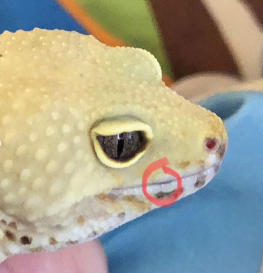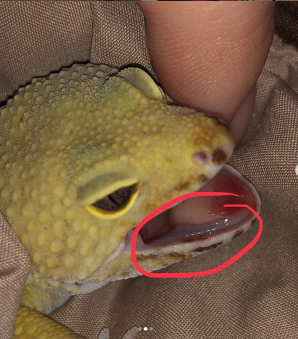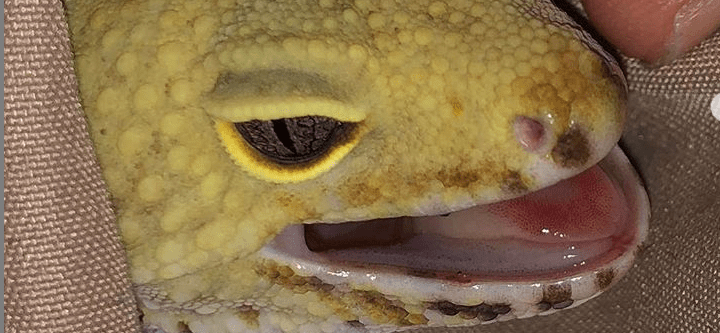It may surprise you to learn that leopard geckos can suffer from oral health-related problems, just like humans!
Like many other reptiles, leopard geckos are polyphyodonts, meaning they continually replace their teeth. Leopard geckos have around 100 teeth which are replaced every 3 to 4 months, but they are tiny, so you probably can’t see them unless you’re looking carefully.
One of most common diseases to affect leopard geckos is called mouth rot, which is where leopard geckos’ gums and mouth get infected with small cuts or pieces of food stuck in their many teeth.
How do I spot mouth rot?
 You can look around the outside of your leopard gecko’s mouth area for small cuts, abrasions or stuck food. If you need to check inside, you can gently and repeatedly stroke along their mouth, and they will usually open it out of irritation which will allow you to peek at their teeth and gums.
You can look around the outside of your leopard gecko’s mouth area for small cuts, abrasions or stuck food. If you need to check inside, you can gently and repeatedly stroke along their mouth, and they will usually open it out of irritation which will allow you to peek at their teeth and gums.
It’s a good idea to check your gecko’s mouth when handling every once in a while just to make sure everything is looking fine.
Also if your gecko has lost interest in food and drink, has any unusual buildups around their mouth, or has any swelling around their mouth or head, then this could be a symptom, and you should absolutely carry out a check.
What do I do if I suspect my gecko has mouth rot?
It is important that you take your gecko to an exotic vet, who is trained in dealing with these issues. You should not use any at-home treatments for your gecko, as any chemicals in and around their mouth could be dangerous or even fatal.
Your vet will likely prescribe some antibiotics or other medication to clear up the problem.
Will it clear up on it’s own/ what will happen if I just leave it?
Mouth rot and any other oral infections can prove fatal to a leopard gecko. If you catch it early there is less likelihood of a more serious infection developing.
How do I prevent mouth rot?
Checking your gecko frequently for all health issues is a good idea, and probably the best way to ensure a small infection doesn’t turn into something bigger and more difficult to treat.
Other than that, ensuring that your gecko has the right housing and setup, and a healthy and balanced diet which is full of vitamins, should keep at bay many common health problems.
However even with the best care, sometimes these things are unavoidable, so the best advice is to be vigilant and watch out for any changes in your gecko
Case study: treating a leopard gecko’s mouth rot. Credit to @AlexanderTheGeck for this information!
 Alexander’s vet visit was primarily to get his mouth checked. Over the last few weeks I’ve noticed a small deformation along his lip, along with discoloration and inflammation along his teeth.
Alexander’s vet visit was primarily to get his mouth checked. Over the last few weeks I’ve noticed a small deformation along his lip, along with discoloration and inflammation along his teeth.
This is a very common early presentation for mouth infection (aka “mouth rot”). If you see even a small discoloured area like this that deforms the lips and doesn’t come off when you give it a light brushing, it’s always a good idea to have it checked out! Left too long, small issues can develop into jaw bone infections, nasal or eye infections, and abscesses that can be life threatening.
Luckily Alexander’s was caught very early. His issue was a shallow bacterial infection caused by some dental plaque build-up. The amazing vets at @avianandexoticvets debrided the area and gave us some topical anti-bacterial solution that should fix him right up. Because it was caught early, he doesn’t need any stronger antibiotics that would mess with his system.
Alexander was apparently a very good boy after some serious wriggling during the initial examination and didn’t give them too much hell during what was basically an extra deep tooth cleaning. Good job, buddy! He’ll be all healed up in the next few weeks.
Get Your Free Leopard Gecko Care Checklist!
Are you ready to give your leopard gecko the best care possible? Download our FREE PDF e-book featuring a comprehensive care checklist!
This handy guide covers everything from habitat setup to feeding and health tips, ensuring your gecko thrives.
👉 Download your checklist now!




